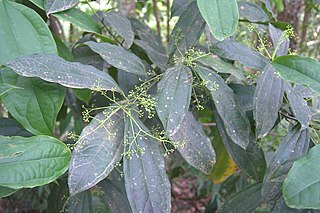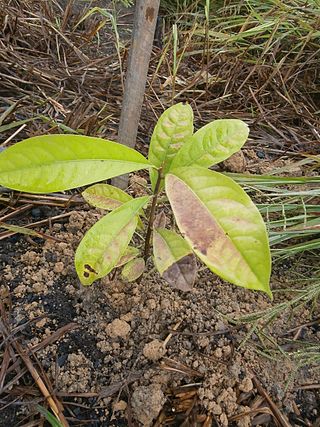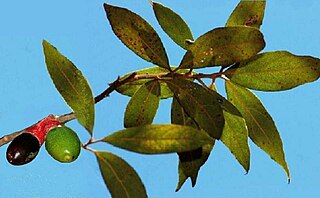
Lauraceae, or the laurels, is a plant family that includes the true laurel and its closest relatives. This family comprises about 2850 known species in about 45 genera worldwide. They are dicotyledons, and occur mainly in warm temperate and tropical regions, especially Southeast Asia and South America. Many are aromatic evergreen trees or shrubs, but some, such as Sassafras, are deciduous, or include both deciduous and evergreen trees and shrubs, especially in tropical and temperate climates. The genus Cassytha is unique in the Lauraceae in that its members are parasitic vines. Most laurels are highly poisonous.

Persea is a genus of about 150 species of evergreen trees belonging to the laurel family, Lauraceae. The best-known member of the genus is the avocado, P. americana, widely cultivated in subtropical regions for its large, edible fruit.

Laurel forest, also called laurisilva or laurissilva, is a type of subtropical forest found in areas with high humidity and relatively stable, mild temperatures. The forest is characterized by broadleaf tree species with evergreen, glossy and elongated leaves, known as "laurophyll" or "lauroid". Plants from the laurel family (Lauraceae) may or may not be present, depending on the location.
Stinkwood, german Stinkholz, french Bois Puant, is the common name for a number of trees or shrubs which have wood or plant parts with an unpleasant odour, including:

Ocotea bullata, is a species of flowering tree native to South Africa. It produces very fine and valuable timber which was formerly much sought after to make furniture. Due to over-exploitation it is now a protected species. Other names for it are Cape Walnut, Cape laurel, and laurel wood. The name "stinkwood" comes from a strong smell that is released when it is fresh felled.
Kuloa usambarensis is a species of tree in the laurel family (Lauraceae). It is native to eastern Africa in Kenya, Tanga Region of Tanzania, and locally in Uganda, where it occurs at 1600–2600 m elevation in high rainfall Afromontane cloud forest. Common names include East African camphorwood, mkulo (Tanzania), mwiha (Uganda), muwong, muzaiti, and maasi.

Aiouea is a genus of shrubs and trees in the family Lauraceae. It is native to tropical forests and montane forests of North and South America. The name is a curiosity because it consists entirely of vowels.

Aniba is an American neotropical flowering plant genus in the family Lauraceae. They are present in low and mountain cloud forest in Caribbean islands, Central America, and northern to central South America.

Beilschmiedia is a genus of trees and shrubs in family Lauraceae. Most of its species grow in tropical climates, but a few of them are native to temperate regions, and they are widespread in tropical Asia, Africa, Madagascar, Australia, New Zealand, North America, Central America, the Caribbean, and South America. The best-known species to gardeners in temperate areas are B. berteroana and B. miersii because of their frost tolerance. Seeds of B. bancroftii were used as a source of food by Australian Aborigines. Timbers of some species are very valuable.

Licaria is a flowering plant genus in the family Lauraceae, native to Central America and South America. It is a Neotropical genus with around 80 species.

Mezilaurus is a genus of plant in the family Lauraceae. It is a neotropical genus consisting of 18-27 species, mostly hardwood evergreen trees, occurring from Costa Rica to the southeast of Brazil. Thirteen species have been identified in Brazil, distributed mostly in the Amazon region. In Rio de Janeiro state only M. navalium (Allemão) Taub. ex Mez has been recorded. Some species have been reported within the Cerrado and in semideciduous forest surrounding the Pantanal Matogrossense. The name Mezilaurus refers to its similar appearance to the genus Laurus.

Nectandra is a genus of plant in the family Lauraceae. They are primarily Neotropical, with Nectandra coriacea being the only species reaching the southernmost United States. They have fruit with various medical effects. Sweetwood is a common name for some plants in this genus.

Ocotea foetens, commonly called til or stinkwood is a species of tree in the family Lauraceae. It is evergreen and grows up to 40 m tall. It is a common constituent of the laurisilva forests of Madeira and the Canary Islands. Leaf fossils of this species are known from the Mio-Pleistocene of Madeira Island.

Ocotea odorifera is a species of plant in the family Lauraceae. It is an evergreen tree in the genus Ocotea.

Endlicheria is a neotropical plant genus consisting of approximately 60 species, occurring mostly in northern South America and the Amazon region. Most species are medium-sized trees, sometime up to 40 metres in height, but a few species are shrubs. DNA molecular data shows that it is closely related to Rhodostemonodaphne and Ocotea.
Rhodostemonodaphne is a genus of flowering plants in the family Lauraceae. It is a neotropical genus consisting of approximately 41 species occurring in Central America and northern South America. This genus has many species that are valued for timber. The classification of the genus is unclear since the species in the genus fall into a well-supported but unresolved clade that also includes species with unisexual flowers currently placed in the genera Endlicheria and part of Ocotea.
Aiouea cinnamomoidea is a species of tree in the laurel family (Lauraceae). It is native to the states of Oaxaca and Guerrero in southern Mexico.
















